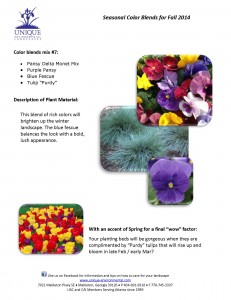Our picks for the 2014 Fall seasonal landscape color blends are here! Call us today.
2014 Fall Seasonal Color Blends Announced for Atlanta Area
Unique plants for your winter landscape
 Does your landscape needs some interest this winter? Try incorporating in these two shrubs and an evergreen perennial into your woodland landscape plantings.
Does your landscape needs some interest this winter? Try incorporating in these two shrubs and an evergreen perennial into your woodland landscape plantings.
Daphne odora is a classic southern fragrance.
Every southern landscape needs Daphne odora to welcome in the fragrance of winter. This evergreen flowering shrub creates a unique feature to your winter landscape, flowering from late January to early March, depending on weather conditions. Its fragrance summons the thoughts of what spring will be.
Daphne is a great plant for a woodland or shade garden, growing only 3 to 4 feet tall on maturity. Mixed in with plantings of hostas and other later spring blooming perennials, it creates a great seasonal mix for your pathways and woodland garden.
Need a winter flowering fragrant shrub for your landscape?
Think of planting Edgeworthia (Paper Bush) shrub. Edgeworthia flowers in the winter months and is a great woodland plant for your landscape. Mix them in with evergreen ferns or heuchera to create nice woodland plantings that are seasonally interesting.
Upside down tulip? No, it’s Hellebores.
Sometimes that’s what Hellebores (Japanese lantern) look like when they bloom. This winter blooming perennial is quite interesting for a woodland garden landscape. The blooms with shades of pink to white make up the color array of this hardy evergreen perennial. Incorporating again Hosta, evergreen ferns and Heuchera along with other early spring and summery perennials creates a long-lasting array of seasonal interest in your landscape.
Volcanoes are for mountains, not trees and shrubs! Don’t over mulch your landscape
 Mulch 2 to 3 inches thick helps maintain moisture around the root zone.
Mulch 2 to 3 inches thick helps maintain moisture around the root zone.
Over-mulching your trees will cause them to decline long-term as the tree cannot breathe at the natural soil level. Also, mulch tends to knit together and can form a barrier keeping rain water from soaking in to the root zone.
This type of over-mulching problem is more prevalent when using hardwood mulch products as they do not decay as quickly as pinestraw. But even when using pinestraw, it may be helpful to remove some of the decaying matter before applying new material.
This problem can also be detrimental to your shrubs in the landscape. Over- mulching shrubs will cause them to surface root into the decaying mulch material and when we get our hot, dry summers, these plants tend to struggle and sometimes die. Again, this problem is more prevalent when using hardwood mulch, but pinestraw over time can build up an unnatural mulch layer that may need to be raked off before applying new material.
Washington Hawthorn Makes a Super Ornamental Tree Choice
A Washington Hawthorn is an excellent ornamental tree that will bring spring color and winter brilliance to your landscape. The Washington Hawthorn is a mid-size tree that bears white flowers in the spring and boasts beautiful red berries throughout the fall and early winter months. Unique Environmental Landscapes chooses this tree for many Atlanta landscapes. Our clients love it.
A Ginkgo Biloba Tree Is a Great Shade Tree and Fall Color Addition
Noted for it’s outstanding brilliant yellow fall color, the Gingko tree is very tolerant and can withstand some pretty harsh conditions. The one thing that must be considered is soil drainage. The Gingko does not like standing water, it prefers a loamy or somewhat sandy soil. It is okay with short droughts, but NOT flooding. It likes a few hours of bright sunlight each day, too much shade could slow the tree’s growth which can grow to enormous heights. At first it grows very slowly and maybe a little crooked, no worries though, it will straighten out and pick up growth after several years.
Low maintenance – The Gingko needs minimal basic fertilization, maybe two times per year. A light layer of mulch at the beginning of each season is adequate. It requires very little pruning unless you want to ‘shape’ the branches which is best done in the spring.
The Gingko plant is readily available at most garden shops. You should know the female variety is fruit producing and this fruit can have a pungent odor. Removing the fruit immediately after it falls helps minimize this problem. Fall is a good time to plant the Gingko or almost any landscape material so it has time to get established before the heat of summer.
Fertilize those Fall Flowers
Like the landscape installation department at Unique Environmental, your fall seasonal color has probably been in the ground for about a month now. You’re thinking the recent rainfall was good and now the sunshine and average fall temperatures should make your cabbage, pansies, and violas happy right? Wrong! It’s time for a feeding. Take advantage of one of the warmer days when it comes along over the next week and fertilize with Peter’s liquid fertilizer. I recommend liquid over granulated now because it will work faster.
More Landscape Tips for your Atlanta Winter Landscape
If you follow our blog, you have noticed Unique is trying to encourage our readers to get moving on their landscape! If you’re not a do-it-yourself type, by all means call Unique Environmental Landscapes and allow our professional, experienced designer and crews do ALL the work for you. Here are three more of our suggestions for adding color to your winter landscape in the Atlanta/Georgia region.
-
Sasanqua Camelia (blooms Oct- Dec) or Japonica Camellia (blooms Feb-Mar) are both a staple of southern gardens. Camellias (camellias) are evergreen shrubs and are available in a variety of ‘blooming’ colors including bright pinks, white as well as bicolor. They are happy in shady or filtered sun and prefer a well draining and rich soil.
-
Winter Daphne is also a winter blooming shrub and is available with choices of a variety of shades of pink flower that open to white. The foliage is edged with a thin strip of yellow, providing a nice contrast on the green leaf. They bloom through winter and into spring in the South – one of Unique Environmental’s favorites. Winter Daphne (Daphne odora ‘Marginata’) prefers full sun/part shade in a nutrient-rich and minimally acidic to alkaline soil.
-
An excellent evergreen perennial choice is Euphorbia. The ‘Glacier Blue’ variety blooms cream flowers Feb – May and the evergreen leaves of blue-grey with creamy white edges make it a garden standout. One of Unique’s favorite characteristics of Glacier Blue is that it’s deer & rabbit resistant, a feature many gardeners will appreciate. Careful though, it is toxic if eaten!! It’s also drought tolerant. Euphorbia x martini ‘Ascot Rainbow’ is another variety with similar characteristics except these differences including foliage and blooms. The stems are reddish in color and the leaves are variegated colors of dusky sage and gold with cream and green flowers (tipped with deep red in fall.) The Ascot Rainbow prefers full to part shade.
Atlanta Fall Seasonal Color Isn’t Just Pansies Any More
While Pansies are a great choice for fall seasonal color here in Atlanta GA, Unique Environmental Landscapes expands the options and chooses from a larger plant pallet when it comes to creating those big, beautiful flower beds we all enjoy throughout the otherwise dormant months.
 One of our first choices is the Red Bore Kale. This plant is not only ornamental but it is also edible. We like to use it as an accent plant with other flowers such as pansies, etc. As it grows, it turns a beautiful dark, deep purple and the leaves are very curly almost resembling clouds. If you want to eat it, pull the leaves from the bottom of the plant where other flowers will cover this area. Kale likes the sun and well drained, moist soil.
One of our first choices is the Red Bore Kale. This plant is not only ornamental but it is also edible. We like to use it as an accent plant with other flowers such as pansies, etc. As it grows, it turns a beautiful dark, deep purple and the leaves are very curly almost resembling clouds. If you want to eat it, pull the leaves from the bottom of the plant where other flowers will cover this area. Kale likes the sun and well drained, moist soil.
Ornamental cabbage is another great choice. It comes in many varieties and colors so choose one that works best with your other plants. Or create a beautiful collage of color by using a variety of cabbage colors. This too, is edible, but probably not as tasty as the cabbage you purchase from your local farmer’s market. Cabbage prefers full sun to partial shade.
Snapdragons offer a splash of bright color and it’s blooms are especially profuse in cooler weather. Winters in the Atlanta area are quite often mild enough that Snapdragons will excel. They are bushy plants with tall spikes of flower buds and offer a good focal point in the garden.
Choose these varieties as good focal points
- Kale Coral Prince
- Cabbage Osaka Pink
- Kale Redbor
- Kale Red Russian
Choose these as good accents:
- Mustard Red
- Giant Swiss Chard “Bright Lights”
- Cardoon (hardy with Atlanta mild winters)
- Euphorbia “Glacier Blue”
- Yucca
- Rosemary
- Dwarf Conifers
Be sure to use appropriate plants for the size of your bed
So, what are you waiting for. Go out and create a fall color bed for a colorful winter!
Irrigating for Fall
It’s time to start thinking about adjusting your irrigation system by reducing the watering schedule for turf zones. Typically, the number of days and time allotted per zone can be reduced this time of year. If the turf zone is currently running 20 to 30 minutes at a time, it can be reduced to about 15 minutes and at least one less watering per week…..saving on the water bill isn’t a bad thing either!
Additionally, when you aerate and over seed, these turf zones may need to be adjusted appropriately as well for the Fescue seeding.
Unique Environmental Displays Excellence At 2010 Flower Show



















